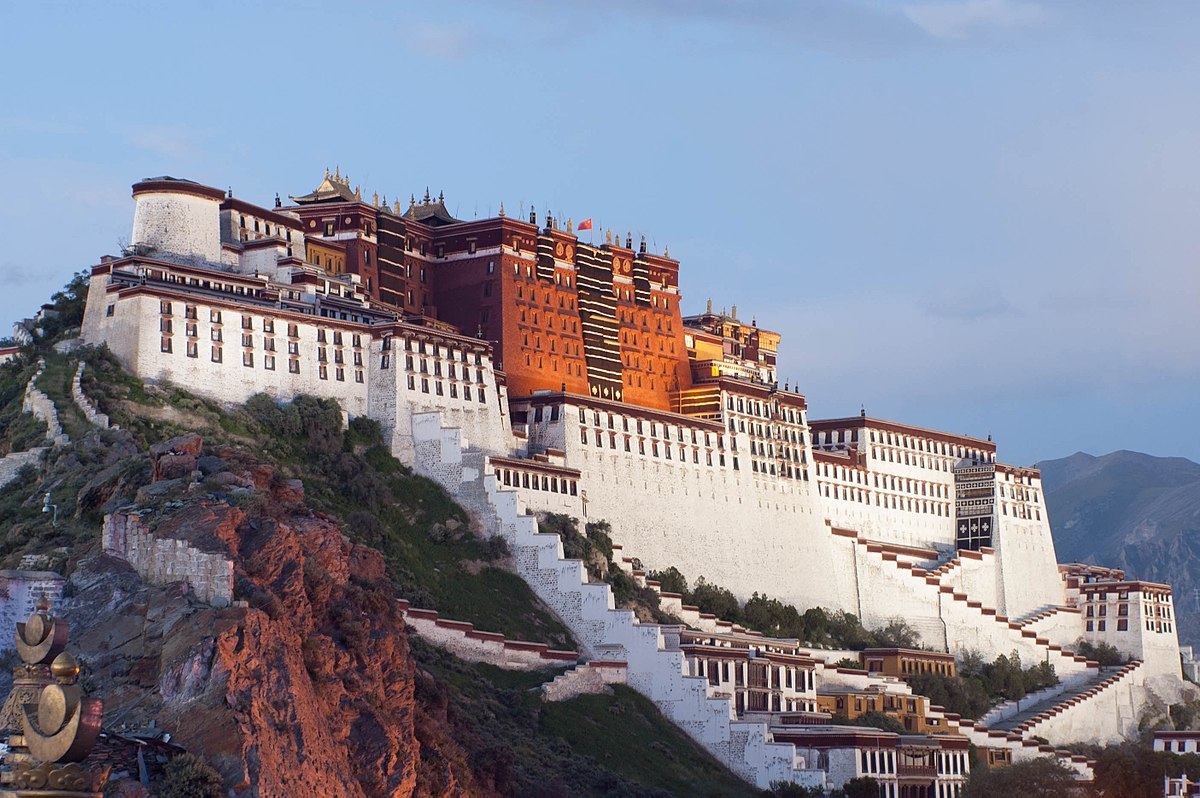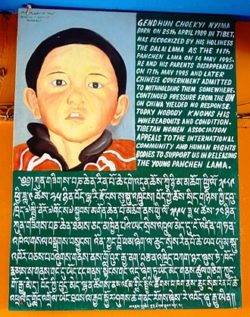'Liberating' the Roof of the World

by Azhar Vickland
“We turned a corner and saw, gleaming in the distance, the golden roofs of the Potala, the winter residence of the Dalai Lama… we felt inclined to go down on our knees like the pilgrims and touch the ground with our foreheads”
This depicts the scene of the majestic semblance of the Potala Palace in Lhasa, the capital of Tibet, in Heinrich Harrer’s Seven Years in Tibet. Harrer narrates his escape from India into Tibet after being detained in a prison camp by British Troops in Dehradun. He records his efforts to gain asylum in Lhasa and how he was able to win the hearts of Tibetan officials. Ending his account with the unsettling change in atmosphere that followed the arrival of the Red Army from China in the 1950s, and the flight of the Dalai Lama into India in 1959.

Heinrich Harrer and the Dalai Lama
I had limited knowledge of Tibet until I read Harrer’s Seven Years in Tibet, which prompted me to further my research on the human rights issues in this plateau region. The social and political state of affairs in Tibet does not receive much coverage on mainstream media due to its ‘irrelevance’ in mainstream political discourse. Nonetheless, it is important to discuss the situation in Tibet as it uncovers the persisting nature of occupation the Tibetan people experience. This article will provide a brief overview of Tibet and the occupation by the Chinese People’s Liberation Army (PLA). The article will move on to discuss the current situation and human rights violations. Lastly, it will consider why Tibet is an important region to China limiting the success of Tibetan resistance.
Firstly, we have to understand the geographic and demographic identity of Tibet. Tibet sits on a plateau on the Himalayan region, southwest of China. Buddhism is the main religion and they hold the belief that the current Dalai Lama is the 14th reincarnation of their spiritual leader and ‘living God’. The population estimates vary widely between different agencies due to inclusion of the wider Tibet region and the inclusion of Chinese settlers, bringing the estimates within the range of 3-6 million.
Historically, Tibet has been ruled by the Dalai Lama who is believed to be their spiritual and political leader. The Dalai Lama is determined through reincarnations, a belief part of Buddhist teachings, therefore having religious authority over the population. This tradition of authority has been maintained for centuries with the threat of it ending with the current 14th Dalai Lama, which I will explain in the following paragraphs.
In 1950 the leader of China, Mao Zedong, imposed the claim that Tibet is a part of China. This led to the ‘Seventeen Point Agreement’ being forced upon the Tibetan leadership. The agreement authorised the establishment of Chinese civil and military institutions but affirmed Tibetan autonomy and respect for the Buddhist religion. However, the agreement mostly failed and was not respected by the Chinese leadership. The tension peaks in 1959, when Tibetans revolted against Chinese rule. The PLA was able to suppress the rebellion by the Tibetans. As a result, the 14th Dalai Lama fled to India with some of his ministers. The political situation has not improved since then, Tibet is still occupied by China and the Dalai Lama has set up a government-in-exile in India.
Moreover, the Chinese leadership has passed a law that that forbids unauthorised reincarnations of the Dalai Lama. The current 11th Panchen Lama, who lives in Tibet and is friendly with the Chinese leadership, was chosen by the Chinese government in November 1995. The Panchen Lama will identify the next Dalai Lama, according to the Buddhist tradition. This effectively means that the next (15th) Dalai Lama will be chosen by the Chinese government; depriving the rights of the Tibetan people to have their own theocratic leader.

The 11th Panchen Lama, a six-year old boy, was first identified by the current Dalai Lama on 14th May 1995, three days later the boy and his family were taken into Chinese custody.
Heinrich Harrer highlights the condition of Tibetans living under Chinese rule in his sequel book, Return to Tibet: Tibet After the Chinese Occupation. He wrote this book after his 1982 revisit to Tibet; commenting on the situation in Tibet, heartbroken because of what he has observed.
The culture and religion of Tibetans have been targeted by the Chinese government, to strengthen their grip on the region. The destruction of Tibetan culture can be dated back to 1966 when the Cultural Revolution reached the region. This resulted in the destruction of Buddhist monasteries and cultural artefacts. It has also been reported that around 1.2 million Tibetans were killed by the Chinese authorities. This amounts to genocide, according to Article II in the Convention on the Prevention and Punishment of Genocide. In recent times, the situation has not improved as Chinese authorities continue to harass ‘dissidents’ and temporarily suspend ties with countries that are friendly with the 14th Dalai Lama.
Next, the discussion has to consider why Tibet is important to the Chinese leadership, this will give us an understanding of the limited success of Tibetan resistance. There are three factors that highlight the importance of the Tibetan region; these are borders, minerals and water. Tibet serves as a buffer zone between India and Nepal. The mountain range functionally being a security and military advantage for China. Additionally, the mining industry in the region contributes largely to China’s wealth with there being around USD$100 billion worth of mineral wealth. Tibet is also the source of ten major river systems of Asia, handing China the control over the rivers to build hydroelectric dams. This can be perceived as Tibet’s resource curse; jeopardising its hope for independence.
The ‘Free Tibet’ movement in the West has simmered down due to the swiftly evolving political climate. Tibetan activists are trying their best to dispel misinformation spread by the Chinese propaganda machine. While, the Dalai Lama has advocated for a democratic mechanism, by setting up democratic political system within the government-in-exile.
The People’s Republic still retains a tight grip on the region in favour of its national and economic agenda. This holds same for other regions with ethnic minorities that are fighting for their rights, autonomy or even independence; such as East Turkestan, Southern Mongolia, Hong Kong and Taiwan. Heinrich Harrer's activism through literature gives a voice to this silenced population, as students we should use our abilities and platforms to involve ourselves in such activism too.
Azhar Vickland, 2nd year BA Politics and Social Policy Undergraduate.
